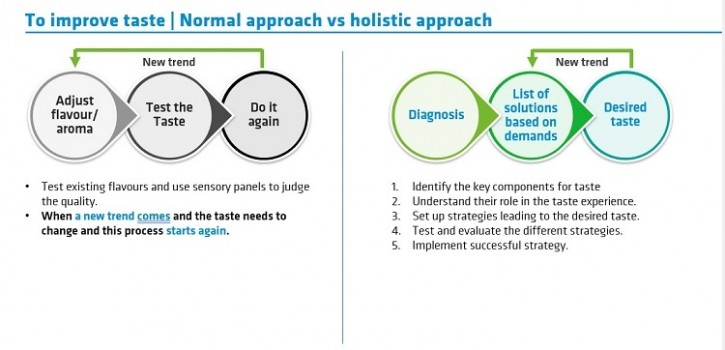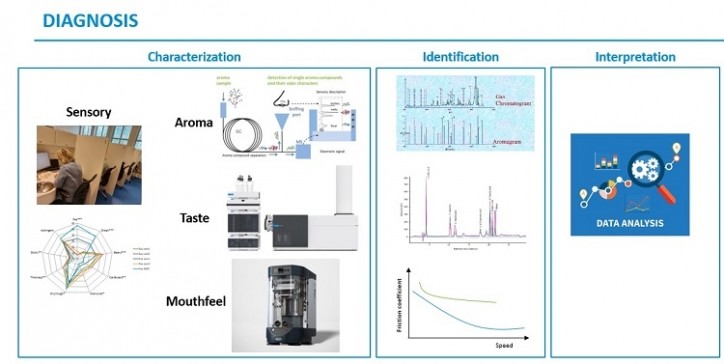[ad_1]
The plant-based sector has made huge strides in improving the flavour of meat and dairy replacement products. This has raised consumer expectations, so if you want to successfully launch a plant-based product onto the market today, you have to go above and beyond in flavour to stand out. Els de Hoog and Ann Stijnman, both Senior Project Managers of Flavour & Texture at NIZO, explain how a new, more holistic approach to flavour could mean an end to compromising.
René Floris: Why is a new approach to flavour issues needed?
Els de Hoog: Food manufacturers and flavour houses have done amazing things to improve the flavour of meat and dairy analogues. But that brings a new challenge. Good is no longer good enough. If you want a new plant-based product to be success, it really has to taste great. Consumers aren’t going to switch to something new unless it is noticeably better tasting than their current favourites. And, despite all the great work so far, manufacturers still often come up against flavour issues.
Ann Stijnman: The current approach to such issues is somewhat trial and error: adjust the formulation (based on expert insight) and test the result with sensory panels, then repeat adjusting and testing until you get the best flavour you can. Not only can this lead to a less than optimal flavour, but it also takes time and, today more than ever, speed to market is a critical factor in a product’s success. What’s more, when a new trend emerges in the food industry, you have to go through the whole reformulate-test-repeat cycle again.
RF: So, what’s the alternative?
EdH: We believe a more analytical and holistic approach could help the plant-based sector – and others like clean label and reduced fat / salt / sugar – take the next step forward in flavour and solve these issues more quickly. This approach has three steps. Step one is to systematically analyse the key components of the flavour of the product to diagnose the root cause of your flavour. Then, in step two, you combine this in-depth understanding of the causes of the flavour issue with knowledge of food processing to create a list of possible strategies for solving the issue. Finally, you consider the pros and cons for each of the strategies and choose the one that best matches your business case.

RF: What are the benefits of such an approach?
AS: Systematically diagnosing the root cause of a flavour issue means you can develop much more optimal solutions and a much better tasting product. Flavour is very complex, combining taste, aroma, texture, mouthfeel and how the food interacts with saliva and the tongue. We have done a lot of research into the compounds that can cause off-flavours in plant-based foods. One thing we found is that the most abundant ‘off-flavour compound’ isn’t always the actual cause of an off-flavour. Perhaps a less abundant compound is more powerful, or the product matrix promotes / suppresses the release of certain compounds into the mouth during eating. A more holistic approach to the analysis helps you better understand such cross-modal interactions between texture, mouthfeel and the perception of flavours.
EdH: The better you understand the actual root cause, the quicker you can find a solution that actually works. With trial-and-error, each change can, for example, subtly affect those cross-modal interactions – so with each iteration you have a slightly different issue to address. The holistic approach is a “solve-once” strategy. What’s more, if things change in your business case or marketplace – for instance, you want to target a different price point – you don’t have to go through the whole process again: you just go back to the list of possible solutions and choose a new one.
RF: What kind of analyses should that diagnostic phase include?
AS: Typically, you would start with expert sensory panels to determine what the perceived flavour issue is: does the product taste too bitter, too beany? Then you need to determine the presence and abundance of the non-volatile compounds that contribute to the taste and the volatile compounds that contribute to the aroma. This can be done with techniques such as gas chromatography, liquid chromatography and mass spectrometry. But to determine which of these compounds contribute to the flavour perception, we use gas-chromatography-olfactometry in combination with mass spectrometry – which combines chemical analysis with human perception. Beyond that, tribology experiments can help you understand the mouthfeel and how that, for example, contributes to a creamy flavour, while human-product interaction experiments can unlock the way in which the process of eating affects the perception of flavour.

RF: Once you have that insight, how do you make use of it?
EdH: Data from all those studies form the basis of an integrated, multi-modal analysis that also draws in an understanding of your production processes and relevant insight from food science. This will reveal the true root cause of the off flavours and how they arise: are they inherent in your ingredients or introduced in the processing?
AS: Armed with that knowledge, it is possible to identify a list of strategies that can address that root cause. This could include reformulating the product with different ingredients or re-organizing your process steps. Additional ingredients to mask the off flavour or incorporating fermentation or biopurification to remove the compounds that cause the off flavour may also be options. In this case, the full analysis can help determine which masking agents or fermentation cultures are the best options. Of course, in many cases, a combination of these approaches may be needed – and again the results of the diagnostic analysis will provide a guide.
RF: And how do I choose the best overall strategy?
EdH: The mitigation strategies identified in this exercise will all work to improve the final flavour of the product. But they are not equal in other ways. For example, the analysis may suggest that removing off flavours through biopurification gives the best flavour but adding a masking agent would be, say, 90% as effective and significantly cheaper. Or that reformulation would be quicker, but adding a fermentation step would let you position the product as a more-natural, clean label option.
AS: In the end, it comes down to the business case the manufacturer has identified for that particular product. But going through the holistic approach will give you the insight you need to make that decision with confidence. It is the key to unlocking the next step in flavour for plant-based and so many other products.
In our next column, we will be looking at health benefits of food.
[ad_2]
Source link
